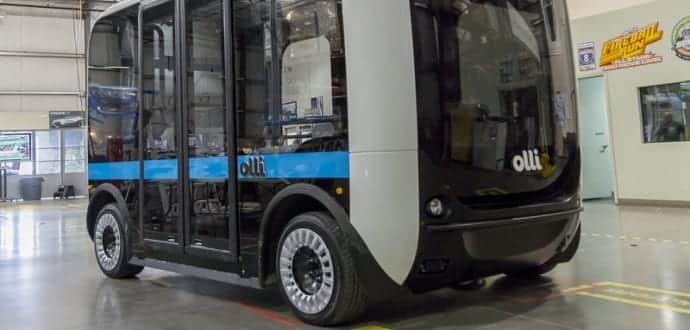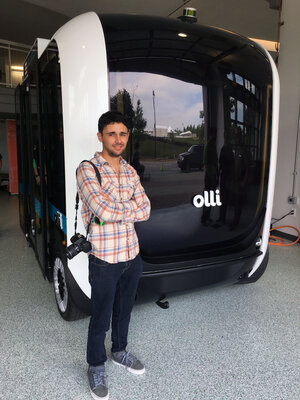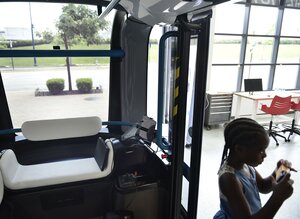This Self-Driving Minibus Designed By A 24-Year-Old, was Constructed In Few Weeks By The Maker
Edgar Sarmiento, a 24-year-old designer who designed a new self-driving shuttle bus called Olli, sat perched on a stool nearby with his hands holding a camera in his lap at the recent unveiling of the vehicle. He and Olli had just met several hours earlier.
Sarmiento started working in 2014 at a design agency in Bogota after he got his industrial design degree in his native Colombia. However, the job was not satisfying for him.
“The problem in Colombia is that product design, it’s not as strong,” Sarmiento says. “When industrial designers start working in the field … you start to work in graphic design, in publicity, in interior design.”
So, he started exploring online and found himself in a digital design community run by an Arizona-based carmaker, Local Motors popular for its 3D printed car. The company depends on people like Sarmiento to get brand-new vehicles to market in few weeks — a business model driven by co-creation (a cousin of crowdsourcing) and micro manufacturing (a cousin of small-batch, locally sourced production).
“We want the fastest speed to a good idea commercialized in the market; we want to be the maker; we want to sell it and service it out of our factory,” says John B. Rogers Jr., Local Motors CEO.
A million vehicles
Rogers’ first big thought was developing localized and digitized made-to-order manufacturing, powered by 3D printing, to release the so-called economy of scope, which is in contrast to the economy of scale.
“High volume, low pricing power, low cost, low margin — that’s what Toyota or Hyundai have done very well with the automotive industry,” Rogers says.
His visions are on low volume, low production cost, high price, high margin: “My economy comes from being able to drive up my price because I can introduce new technology and get you to pay more because it’s not available on another vehicle.”
Rogers says his ambition is to produce a million vehicles, “each one of a 20,000-unit run, where I’m profitable on a hundred vehicles in each of those runs.”
But how do you whip out so many vehicle ideas quickly? It didn’t seem effective hiring a team interesting to the Internet’s store mind. So, the Local Motors co-creation community was born. There, the company arranges competitions and challenges for designs of land and air vehicles.
“Most of our vehicles are designed by people who don’t work for us,” says Justin Fishkin, Chief Strategy Officer. “We haven’t used an idea from a 6-year-old yet, but I bet you in the next decade, there will be an idea from a young person that ends up in one of our cars.”
The Hiriko car was uncovered at this event at European Union headquarters in Brussels bringing a lot of excitement in 2012. At the time, Jose Manuel Barroso, the then-President of the European Commission had addressed the car as a trans-Atlantic “exchange between the world of science and the world of business.”
In return, the designers get royalties: a winner’s payment, plus, if the vehicle gets commercialized, a 1 percent to 2 percent royalty off the top price of each item sold. Rogers’ plan is to also split another 1 percent to 2 percent among key community members who help enhance the design.
From parts to done, in two weeks
Until now, Local Motors has manufactured lesser than a dozen vehicle models, and only a few have been truly commercialized, including the now-discontinued $1,500 electric tricycle Verrado (1,500 sold says Rogers) and the $100,000 Rally Fighter (100 sold till now, he says).
Olli is Local Motors’ latest. This is different, as it is a self-driving system rather than a vehicle. Further, this app-solicited shuttle bus powered by the learning and predictive computer technology of IBM’s Watson is targeted at cities or companies rather than individual buyers.
Olli became a reality with the help of some 100 partner companies. It started as a boxy sketch and was at one point called “Edgar 8” after its designer before becoming the curvy, puffy reversible minibus Olli.
“This is the first time that I see a product that I designed, to see it in a real scale,” Sarmiento says. He has designed a few dozen products and put in other competitions before but had never seen his creations manufactured. Last, he had seen Olli, it was a 2-foot-long, 3D scale model.
“For a long time,” he says of his first real Olli encounter, “I was looking, analyzing, I can’t believe that it’s real.” But no crying. “Not much,” he says, laughing.
Rogers says that it took Local Motors 2 1/2 months to arrange the suppliers, finish the design and get going on 3D printing of the parts from the moment Sarmiento’s winning design challenge entry was okayed for production.
“From the time when we put all the parts on the floor and said, ‘We’re going to build it,’ “Rogers says, “to build the first two, it took two weeks.”
“I think they need us.”
Rogers’ points of pride are the openness of operations and the speed, which is what, differentiates Local Motors from any other car manufacturer or tech company entering into self-driving vehicles.
He says Local Motors is not like Porsche with secret testing tracks and big unveilings at auto shows. It’s not like Google, which claims self-driving fame but doesn’t make actual vehicles, nor like Apple, who is known for being secretive, dictatorial and submerging in its partnerships.
“We will share with our community to the end,” Rogers says, “till we die.”
It’s also not like Tesla. “They built a very expensive factory,” Rogers says, and spent years constructing the Model S, followed by the future Model 3. “But Local Motors is making vehicles with better autonomous technology right now and putting them at low volume in the market.”
Referring to Google and Tesla, he says, “In a sense, I think they need us.” As a low-volume, high-margin maker, Local Motors “pierces the market” and goes on, he says, leaving it up to the remaining to carry the innovations through. “We make it clear what people want,” Rogers says.
He says his company did approach Google for a partnership, to put Google’s self-driving technology into Local Motors cars. “So far they haven’t said yes,” Rogers says. “And I think now that we see so much interest from so many other companies, I’m not sure how useful partnering with Google would be.”
Local Motors says that it has received orders for 10 Olli shuttles until now and has paid Sarmiento $28,000 in total, for winning the challenge and for his design making it to market. Sarmiento, who is now studying transportation design in Italy, will later receive additional royalties, though the amount is not clear as the company is not revealing Olli’s price.
The original Olli is being test-run this summer around National Harbor, south of Washington, D.C.


